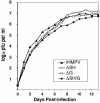Recombinant human Metapneumovirus lacking the small hydrophobic SH and/or attachment G glycoprotein: deletion of G yields a promising vaccine candidate
- PMID: 15542640
- PMCID: PMC525014
- DOI: 10.1128/JVI.78.23.12877-12887.2004
Recombinant human Metapneumovirus lacking the small hydrophobic SH and/or attachment G glycoprotein: deletion of G yields a promising vaccine candidate
Abstract
Human metapneumovirus (HMPV) has recently been identified as a significant cause of serious respiratory tract disease in humans. In particular, the emerging information on the contribution of HMPV to pediatric respiratory tract disease suggests that it will be important to develop a vaccine against this virus for use in conjunction with those being developed for human respiratory syncytial virus and the human parainfluenza viruses. A recently described reverse genetic system (S. Biacchesi, M. H. Skiadopoulos, K. C. Tran, B. R. Murphy, P. L. Collins, and U. J. Buchholz, Virology 321:247-259, 2004) was used to generate recombinant HMPVs (rHMPVs) that lack the G gene, the SH gene, or both. The DeltaSH, DeltaG, and DeltaSH/G deletion mutants were readily recovered and were found to replicate efficiently during multicycle growth in cell culture. Thus, the SH and G proteins are not essential for growth in cell culture. Apart from the absence of the deleted protein(s), the virions produced by the gene deletion mutants were similar by protein yield and gel electrophoresis protein profile to wild-type HMPV. When administered intranasally to hamsters, the DeltaG and DeltaSH/G mutants replicated in both the upper and lower respiratory tracts, showing that HMPV containing F as the sole viral surface protein is competent for replication in vivo. However, both viruses were at least 40-fold and 600-fold restricted in replication in the lower and upper respiratory tract, respectively, compared to wild-type rHMPV. They also induced high titers of HMPV-neutralizing serum antibodies and conferred complete protection against replication of wild-type HMPV challenge virus in the lungs. Surprisingly, G is dispensable for protection, and the DeltaG and DeltaSH/G viruses represent promising vaccine candidates. In contrast, DeltaSH replicated somewhat more efficiently in hamster lungs compared to wild-type rHMPV (20-fold increase on day 5 postinfection). This indicates that SH is completely dispensable in vivo and that its deletion does not confer an attenuating effect, at least in this rodent model.
Figures





References
-
- Biacchesi, S., M. H. Skiadopoulos, G. Boivin, C. T. Hanson, B. R. Murphy, P. L. Collins, and U. J. Buchholz. 2003. Genetic diversity between human metapneumovirus subgroups. Virology 315:1-9. - PubMed
-
- Biacchesi, S., M. H. Skiadopoulos, K. C. Tran, B. R. Murphy, P. L. Collins, and U. J. Buchholz. 2004. Recovery of human metapneumovirus from cDNA: optimization of growth in vitro and expression of additional genes. Virology 321:247-259. - PubMed
-
- Buchholz, U. J., S. Finke, and K. K. Conzelmann. 1999. Generation of bovine respiratory syncytial virus (BRSV) from cDNA: BRSV NS2 is not essential for virus replication in tissue culture, and the human RSV leader region acts as a functional BRSV genome promoter. J. Virol. 73:251-259. - PMC - PubMed
-
- Bukreyev, A., S. S. Whitehead, B. R. Murphy, and P. L. Collins. 1997. Recombinant respiratory syncytial virus from which the entire SH gene has been deleted grows efficiently in cell culture and exhibits site-specific attenuation in the respiratory tract of the mouse. J. Virol. 71:8973-8982. - PMC - PubMed
-
- Collins, P. L., R. M. Chanock, and B. R. Murphy. 2001. Respiratory syncytial virus, p. 1443-1485. In D. M. Knipe, P. M. Howley, D. E. Griffin, R. A. Lamb, M. A. Martin, B. Roizman, and S. E. Straus (ed.), Fields virology, 4th ed., vol 1. Lippincott-Raven Publishers, Philadelphia, Pa.
MeSH terms
Substances
LinkOut - more resources
Full Text Sources
Other Literature Sources

